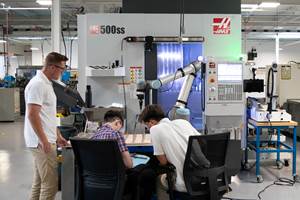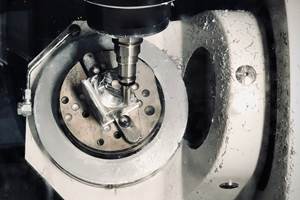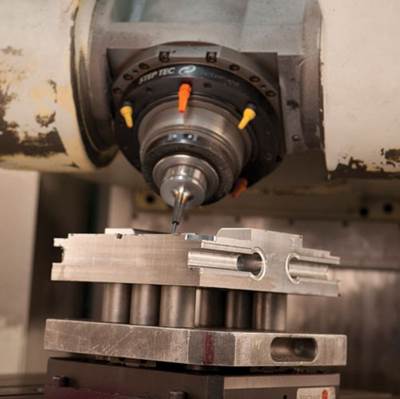Video: Minimizing Mistakes with Laser Scanning łŖŇ‚¬ ŃýļŌ≤
Die Tech & Engineering uses its scanning to łŖŇ‚¬ ŃýļŌ≤ to avoid errors by inspecting electrodes prior to EDM.
Share






Video Transcript
Narrator: Traditionally, inspection with a łŖŇ‚¬ ŃýļŌ≤ is often performed only at the completion of an assembly or machining process. One mold maker has a different way; at Die-Tech & Engineering, near Grand Rapids, Michigan, inspecting electrodes or components during the mold build process helps prevent surprises and big problems at final inspection.
The slow speed of traditional contact łŖŇ‚¬ ŃýļŌ≤ s can be a limitation. At roughly one point per second or less, though inspection can take a lot of time. A laser scanning łŖŇ‚¬ ŃýļŌ≤ is much faster, normally collecting thousands of points per second. A laser scanner works by reflecting light off a surface. The reflected light is measured by its location on a sensor, much like a camera. The location is then triangulated to measure each point’s offset from the laser.
Die-Tech & Engineering’s Bill Berry was being pressured to buy a traditional łŖŇ‚¬ ŃýļŌ≤ by his customers.
Bill Berry: I avoided buying a łŖŇ‚¬ ŃýļŌ≤ until that point, because in my opinion, there was not a value add to owning one of those piece of equipment. Because it was too late. You were just getting a scorecard on what you already did, not a way to improve or prevent mistakes.
N: Investigation revealed that a fast, laser scanning łŖŇ‚¬ ŃýļŌ≤ could offer a better solution, but only if he used it during the process, not at the end.
BB: For many years, we were very aware that some of the big problems that can come in the manufacturing of dies and molds are during the build process with all of the various components. Especially in the EDM are that we use, and we didn’t have a good way to inspect those. We incorporated laser scanning łŖŇ‚¬ ŃýļŌ≤ into our operations so that we could do in process gauging and reduce the number of mistakes we had and improve the quality before we complete the die.
N: Scanning all of the electrodes before they were used, helped ensure that EDM processes were error free. Once installed, Die-Tech found more uses for it’s scanning laser łŖŇ‚¬ ŃýļŌ≤ .
BB: Initially, that was our concept. We need to make sure that our electrodes are precise enough, in a correct position, programmed correctly to use. But, we had enough capacity in the machine that we also integrated scanning of separate, discrete components like corepins, that would validate the machining operations, that were many times, done by skilled craftsmen, outside of the control of the engineering department, on conventional grinding equipment, or other methods. The risk for not completely inspecting those things was so great, that we found a way to inspect them with very little additional cost.
N: Note the simplicity of set-up for scanning these corepins. A generic set-up sheet for the corepin scanning is simply taped on to a blank palette, and the pins are then just set on that drawing to identify them. The scanning laser software automatically finds each pin’s alignment, based on the scanned data.
Today, Die-Tech not only inspects the electrodes before they go into the EDM, the shop also verifies the burns set-up instructions on the virtual part. The electrode is scanned, the burns set-up instructions from the tool path department are entered into the laser scanning łŖŇ‚¬ ŃýļŌ≤ system, and then the scanned electrode data is located on the part’s detail. This provides complete verification of the electrode and burn process in a virtual environment, before the steel is burned in the EDM.
Here’s an error discovered by the laser scanning łŖŇ‚¬ ŃýļŌ≤ . Each electrode was properly designed, and set-up instructions were correct. Still, when burned in the insert, the clearance portion of one electrode, would have violated the steel on the adjacent geometry in one of its’ burned positions. The laser scanning łŖŇ‚¬ ŃýļŌ≤ caught the problem in the virtual world, before actually starting to burn the real insert. The violating area was relieved from the electrodes, averting a big problem.
At Die-Tech, the shop doesn’t only inspect after machining is already done. For EDM the shop thoroughly inspects before machining, so errors never make it to the real world.
Click here to learn more about supplier Nikon Metrology.
Related Content
CNC Machine Shop Honored for Automation, Machine Monitoring
From cobots to machine monitoring, this Top Shop honoree shows that machining technology is about more than the machine tool.
Read MoreHow to Successfully Adopt Five-Axis Machining
While there are many changes to adopt when moving to five-axis, they all compliment the overall goal of better parts through less operations.
Read MoreBallbar Testing Benefits Low-Volume Manufacturing
Thanks to ballbar testing with a Renishaw QC20-W, the Autodesk Technology Centers now have more confidence in their machine tools.
Read MoreThe Future of High Feed Milling in Modern Manufacturing
Achieve higher metal removal rates and enhanced predictability with ISCAR’s advanced high-feed milling tools — optimized for today’s competitive global market.
Read MoreRead Next
Find Your Speed Outside of Machining
This short-lead-time mold shop achieves its most significant time savings by looking outside the machining cycle. However, one of those elements outside the cycle—palletized setup—ultimately led to cycle time savings via five-axis machining.
Read MoreMachine Shop MBA
Making Chips and łŖŇ‚¬ ŃýļŌ≤ are teaming up for a new podcast series called Machine Shop MBA—designed to help manufacturers measure their success against the industry’s best. Through the lens of the Top Shops benchmarking program, the series explores the KPIs that set high-performing shops apart, from machine utilization and first-pass yield to employee engagement and revenue per employee.
Read MoreAMRs Are Moving Into Manufacturing: 4 Considerations for Implementation
AMRs can provide a flexible, easy-to-use automation platform so long as manufacturers choose a suitable task and prepare their facilities.
Read More





















